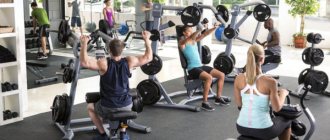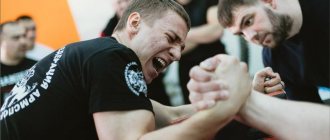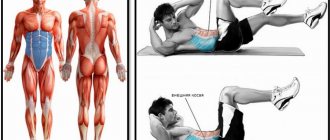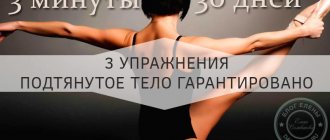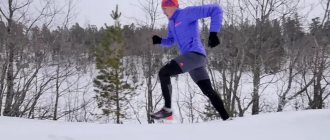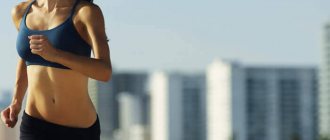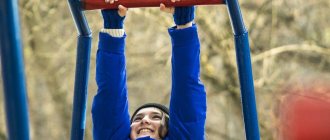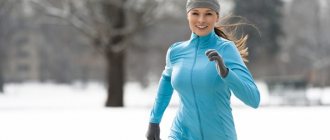Companies selling hypoxic masks claim that this relatively simple device can provide the same benefits as training at altitude, but at a much lower cost. In this article we will figure out whether this is so.
It may seem that only runners use training masks, but the list of end users is not limited to them. Masks are used in cycling, skiing, martial arts, mountaineering, swimming, in strength sports to improve breathing rhythm and concentration, in football, basketball and even hockey to increase endurance and physical condition.
Approximate clothing for a winter race
It just so happens that the air temperature in winter can fluctuate from zero and below. Regardless of whether the air temperature is minus or zero, your clothes should be selected correctly. We offer you an approximate version of sportswear for runners in winter.
Dear ladies are recommended to first choose a special bodysuit. Firstly, these sports bras perfectly support the chest while running, and secondly, they do not constrain or impede movement. Men should give preference to special T-shirts, T-shirts or thermal underwear.
The next important detail for runners is the long sleeve. It is advisable to choose models whose sleeves contain holes for the thumbs. In such clothes you are not afraid of the wind, and you do not have to worry about losing heat. For example, this could be a product made from special water-repellent and heat-preserving Thermal Fit or Dri-Fit fabric. We will tell you further about how to select a mask for running in winter.
Another important point is tights or leggings. Depending on the time of day you are jogging, you should choose models with or without reflective details. Also, such products may contain insulation that does not spread over the entire surface, but only on those parts where the feet most often freeze. For example, the insulation may be located in the area of the front of the thigh.
Very important elements of uniform are a windbreaker with a hood and a running mask. We'll tell you more about the features of the latest accessory. At the final stage, a hat and winter sneakers are selected. If desired, you can also wear a not too puffy sports vest under the bottom of your windbreaker.
Running in winter for weight loss
It’s not just extreme athletes who remember running in winter to lose weight. Many girls think about this, especially in the context of the constant rise in price of membership in fitness clubs and huge queues for treadmills in these establishments. Running will help you burn calories and strengthen your heart and muscles.
True, skeptics believe that more people talk about running in winter than actually run – slippery paths, frost and wind quickly discourage physical fitness achievements.
However, this type of exercise can be very effective for burning fat and getting into shape, and for acquiring truly good health.
Who is suitable for running in winter for weight loss?
Of course, you can come across rave reviews that this type of fitness is for everyone, however, in reality this is not the case. For many people, this is too much stress, which can have a negative impact on both weight loss and health. Remember that cold exercise is not recommended if:
- Tendency to colds, if you get sick 2-3 times during the cold season, it is better to start with milder hardening procedures;
- Chronic sinusitis, tonsillitis, bronchitis;
- Varicose veins, especially if jogging is prohibited by a phlebologist;
- Adherence to very strict low-calorie diets - because of them, in combination with running, immunity can decrease and metabolism can slow down. As a result, you will stop losing weight and will get sick quite a lot.
The advantages of winter running are:
- The ability to burn a lot of calories – up to 900 per workout;
- Hardening the body;
- Strengthening the muscles of the legs and “core” (abs, lower back). While driving on snowy paths, you get a fundamentally different load, which allows you to improve your figure, and not just burn calories;
- Acceleration of metabolism - according to scientists from the University of Birmingham, winter running allows you to burn more calories at rest within 4-5 hours after exercise;
- “Good” stress, overcoming adaptation to training, improving results in running in general and fitness in particular.
But unfortunately, it is impossible to say that jogging will not require any expenses - you will need special shoes, running leggings or even overalls for running in winter, a mask, a cap, gloves, and several layers of clothing to protect against frost and wind.
How to run properly in winter to lose weight
First of all, take care of your equipment. You should run in special sneakers.
Those who are prepared can use winter trekking boots, but their soles practically do not bend, and running in them is not very comfortable.
Sometimes they run in “outdoor” hiking shoes; their soles also protect against unnecessary slipping. Don't forget about thermal underwear if you train in temperatures below minus 2 degrees.
Be sure to do a warm-up, and you should do it not in the cold, but at home. Several sets of squats, lunges and light stretching of the legs and back are what you need. After warming up, “jump” into the suit and lightly jog from home to the training place. This approach will protect you from hypothermia and injury.
Start with easy distances, run where the paths are cleared and there are no very icy areas. Breathe only through your nose, try to forcefully lengthen your inhalation and exhalation so as not to catch a cold.
Work for at least 20 minutes, then run home and stretch your muscles there.
Only well-trained professionals can stretch in the cold; it is better for athletes to avoid this.
Train no more than 4 times a week; jogging too often can lead to overtraining. It’s better to use winter as a reason to master strength exercises “additional” to running, and your figure will be slimmer.
Source: https://yourdietonline.ru/?p=2637
What are the features of a running mask?
A mask is an amazing sports accessory that allows you to protect your neck and parts of your face from hypothermia while running. As a rule, such parts of a sports wardrobe are made of a special one-piece breathable material that retains heat and does not allow moisture to pass through.
At the same time, such products do not constrain your face. Despite the peculiar curtain, it breathes and receives oxygen. In addition, a running mask in winter does not make breathing difficult and protects you from cold air currents.
Summary
Despite the fact that running in a mask will allow you to train your respiratory system, this will not lead to an increase in performance, that is, your result will change little compared to if you were preparing for the start in the usual way.
So is it worth training in a hypoxic mask then? To date, there is not enough scientific evidence to support the use of a mask, but it has long been proven how systematic training, proper recovery and nutrition greatly influence our performance.
Balaclava masks for running
A balaclava is a sports mask for running that looks like paraphernalia from films about robbers. It contains two eye holes, covering the nose, mouth, forehead and throat.
Another type covers the ears, forehead and neck, leaving one large hole for the eyes, nose and mouth (reminiscent of a rescue diver's uniform). Moreover, both types of balaclava are capable of retaining heat within temperature limits from +5 to –35-40ºС.
For jogging in severe frost, it is best to use a specialized ski balaclava. This product is made from a special technological material that can protect against freezing and weathering. It fits perfectly to the face and has an elastic texture that can wick away excess moisture. These models often have small, almost invisible holes for the mouth and nose, making breathing easier while running.
Running clothes in winter
12/13/17 Stanislav Sambursky
So, the question “To run or not to run in winter” is not worth it for you. Run! And period! But another question arises - what to run in? The general rules are also clear - keep your hands and head warm, don’t slip on icy paths, don’t fall... And once you’ve set foot on this slippery path, rest assured that your sneakers will help you stay on it.
Sneakers
The leg should be comfortable and warm. This means that we give preference to sneakers that are insulated, high, with a large tongue and replaceable insoles. Choose shoes with high-quality elastic soles that will not slip or freeze in low temperatures. And always with a pronounced tread. The grooved sole will provide reliable grip on icy surfaces.
Thermal underwear
If it’s very cold and you really want to run, thermal underwear will come in handy. The main function of thermal underwear is proper thermoregulation: do not get wet, remove excess moisture, leaving the body dry and warm.
Therefore, you can’t do without synthetics here. One hundred percent cotton is pleasant to the touch, environmentally friendly, but will quickly get wet. The composition of the “correct” thermal underwear includes up to fifty percent cotton.
Everything else is synthetic materials - propylene, polyester and others.
Socks, gloves, hat
Mandatory attributes for winter jogging. It is better to refuse knitted socks, even a gift from your grandmother. Choose high socks to reliably protect your ankles, without seams. The best thermal socks are for running. Gloves, or better yet mittens, will protect your hands from chapping and frostbite, and a hat will protect your head from hypothermia.
Outerwear
There are special requirements for outerwear - sports trousers and jackets. They should reliably protect you from wind and rain outside, retain heat inside and remove excess moisture. Ideally, the jacket covers the lower back and hips, but does not interfere with movement.
Interesting masks - buffs: structure and features
Buff is an unusual and stylish mask for breathing while running. It is usually made from wool. Suitable for everyday wear at temperatures from 0 to -30 ºС.
This model is interesting because it can be worn in one of three positions. The first option: the product is worn as a hood or hood, covering the back of the head, forehead and neck to the chin, leaving only the oval of the face on the surface. Second option: put on, as in the first case, only the free part of the folds of the product is pulled over the nose, exposing the eyes. Third option: the accessory is worn like a kind of scarf on the hair, completely hiding it underneath.
There are also models that resemble a thick hair band in shape. They can be worn instead of a hat on your head, cover your mouth and neck, used as a scarf, tied on your arm, etc.
What Science Says
A study was conducted at Arizona State University on the effect of training with high-altitude masks. 10 cyclists with moderate training were divided into two groups. All participants performed the same training programs for three weeks, the only difference being that some did it while wearing a high-altitude mask, while others did not.
Athletes completed multiple performance tests before and after the training program to determine whether mask use had an impact on performance. After three weeks, the subjects from the first group, who used hypoxic masks, demonstrated a noticeable increase in the strength and endurance of the respiratory muscles. Source: Morgan, DW; Kohrt, W. M.; Bates, B.J.; Skinner, J. S., Effects of Respiratory Muscle Endurance Training on Ventilatory and Endurance Performance of Moderately Trained Cyclists. International Journal of Sports Medicine 1987, 8 (2), 88-93.
Of course, both groups showed an increase in oxygen consumption and performance due to training, but wearing a mask did not allow the first group to outperform the second.
Several other studies with larger samples also found no significant benefit from masks. Some scientists have tried to combine the results of various tests. One such paper, published in 2012, concluded that training masks provide an advantage to less trained athletes and have less of a positive effect on the physiology of a top athlete. Source: Illi, SK; Held, U.; Frank, I.; Spengler, C. M., Effect of Respiratory Muscle Training on Exercise Performance in Healthy Individuals A Systematic Review and Meta-Analysis. Sports Medicine 2012, 42(8), 707-724.
This effect is quite common when a new runner's form improves very quickly, but the more trained they become, the more specific a stimulus is required to bring about further improvement.
Mask for developing endurance
There is another creative mask that visually resembles a respirator or gas mask. It is equipped with head and ear holders and air resistance valves. Unlike previous variations, such an accessory, in addition to its protective function, also serves as a kind of simulator for the respiratory system and lungs.
The principle of operation of such a product boils down to the following: during jogging, the holes through which oxygen moves and is transported during breathing narrows. As a result, the body receives a large load, comparable to climbing a high mountain range in the Alps. Interestingly, such breathing masks (for running) are used during their workouts by such stars as Cameron Diaz, Jessica Biel, Justin Timberlake and others.
How does a breathing mask work?
Initially, the mask provides additional training for the respiratory muscles - both primary and auxiliary. The tropism of the cells responsible for gas exchange increases several times. In other words, your body's sensitivity to oxygen increases and you begin to absorb much more of it.
Few people know, and I myself didn’t know before, that in the respiratory organs there is something resembling a “dead zone”: not every cell of the system takes part in breathing, certain zones may simply not turn on, they already have enough oxygen. As soon as you put on a mask, your body immediately finds itself in a situation of severe stress and over time it begins to get used to it and adapt.
All cells take part in the respiratory process, even those that were previously “sleeping” work. As a result, you begin to absorb maximum oxygen. In addition, the body begins to train anaerobically. This is a very big plus for athletes who are used to working at a high heart rate - it will be easier for them to endure a similar state during competitions. This is because “high heart rate” is synonymous with “anaerobic threshold”.
Not everyone knows how to use it!
The training mask should be attached to the head using fastening elastic bands that are fastened with Velcro. In the kit you will find valves with membranes. According to the classics, there should be one day off and six input. Visually, the mask reminds many of a gas mask - but here the eyes are not closed - others say that it is like a construction respirator.
All parts of the breathing simulator can be easily cleaned: the sleeve can be washed by hand, the frame can be specially treated with an aerosol and blotted with a napkin.
The mask works on the following principle: when a person begins to breathe, due to the fact that the valves in the mask are closed, he does not have enough air.
The athlete is able to adjust the percentage of resistance, creating a simulation of being at different heights from 1 km to 5 km. Before classes, the mask is adjusted by simple manipulations of the membranes and valves. To simulate a height of 1 km, the membrane is opened and a valve with two pairs of holes is attached to it. To adjust the altitude of 2 km, a valve with a pair of holes is taken, for 3 km - with one hole. A height of 3.5 km is simulated by valves with 2 pairs of holes, while one membrane is inserted in a closed position.
To conduct your training at an altitude of 4.5 km, the valves must have a pair of holes and one membrane, it must be closed. For 5 km, install a valve with one hole and one membrane, which remains closed.
Some useful tips for you
- Before using the mask, I recommend that you still consult a doctor; this should be done by those who have any pathologies or health problems. Upon purchase, the buyer undertakes that he will use the mask only as written in the instructions.
- What can an athlete expect? Firstly, the muscles will be better developed, and all due to the fact that they will absorb less oxygen, this has a positive effect on their functionality. If you take into account running, cycling and skiing, then the mask will additionally increase endurance (in other words, despite the fact that you will be wearing a mask, running, riding and pedaling will be much easier). If we take into account martial arts, then, in all likelihood, there will be less acidification of the muscles during the fight.
- Before using the mask for its intended purpose, you should read the instructions and strictly follow all recommendations. It describes exercises, what you can do with a mask, as well as how to combine valves correctly. It is indicated how often you should practice. It is described what to do is strictly prohibited.
- During training, the athlete should not associate himself with his achievements. Despite many years of training experience, you cannot carry out hour-long circuit training with a mask. The less prepared you are, the less time your exercises should last. In everything and always know moderation, do not forget that the purpose of the mask is to strengthen the respiratory muscles. The main ones here are static exercises.
Regarding training principles
It’s worth noting that wearing a mask feels like you’re climbing high into the mountains, so your workout should be as calm as possible, in Pilates or yoga mode.
It is no coincidence that the instructions focus exclusively on static movements; active ones are completely contraindicated there. “But how can that be?” - you ask. In all advertisements, and on various videos like this:
we see athletes who exercise and, in particular, run wearing a mask. In this case, you see top-level athletes who are ready for short intense training on the verge of hypoxia. At the same time, they are constantly monitored by doctors.
Many novice athletes, not realizing “what this mask is for,” begin to completely imitate the advertising, thereby bringing harm rather than benefit to their health.
I think you have made conclusions for yourself and now you will definitely understand whether you need a mask and whether you will use it. Waiting for your comments. Don't forget to subscribe to the blog "On the Edge" and invite your friends! Bye!
Text - Agent Q.
What is the cost of masks for winter running?
You can purchase masks for winter running on the Internet and in specialized sports markets. Prices may vary depending on the level of professionalism of the accessory and the manufacturer.
For example, for a product such as a neoprene running mask (for endurance), the price can range from 3,000-8,000 rubles. Ordinary masks in the form of one strip cost about 400-700 rubles, accessories in the form of a balaclava - from 800 to 3000, buffs - about 300-800, and transformable scarves - from 500 to 1800 rubles.
Can amateur athletes use masks?
The buyers of hypoxic masks are primarily amateurs, because for some, training in the mountains is financially inaccessible, and for others, it is impossible due to the rather long time required for such training camps. In modern masks, the load level is adjustable, which allows them to be used by both “advanced” amateurs and those with an average level of physical fitness.
Of course, if you just started running yesterday, you shouldn't be looking for devices to make your runs even harder than they already are.
For those who have been running for a long time, during the first training sessions with a hypoxic mask, it is recommended to follow the principle from simple to complex. At first, you should not set the most difficult mode and train in a mask for more than 30 minutes. Additionally, you shouldn't do every running session wearing a mask. Alternate regular jogging with masked workouts.
What do people say about winter running masks?
The idea of a mask for winter running is not new, but very relevant. According to some fans of frosty running, it is indispensable during strong winds. Others admire the large selection and versatility of accessories. Moreover, you don’t have to spend a lot of money to purchase a product. With skillful hands and imagination, you can knit a balaclava or a universal transformable snood yourself.
Still others say that they were not satisfied with the running mask they purchased, since it is made of second-class rubber. Firstly, it emits an unpleasant odor and requires long-term ventilation before use, and secondly, it has an uncomfortable bar in the nose area and leaves a characteristic red mark after use. Fourth people like the respirator mask. With her they actively work out on exercise machines and run.
In a word, everyone chooses for themselves the mask that suits them.
Oxygen restriction and anaerobic (strength) training
This brings us to mask use and strength training. Let's use the pre-workout warm-up as an example. A set of 15-20 squats takes approximately 20 seconds. Oxygen use is not a major determining factor for these short, high-intensity work sets. However, with a mask, your workout will likely suffer due to your limited breathing during the climb.
Instead of deep, quality breathing synchronized with each rise, you get short, shallow breaths that do absolutely nothing or help. You cannot perform the Valsalva maneuver correctly because you cannot draw in enough air to equalize the pressure.
There is zero scientific evidence that masks will help you with strength training. You will undoubtedly achieve higher intensity and quality of training while breathing freely than if you had to lift less weight and do fewer sets due to a mask.
Where can I buy it and how much does it cost?
You can buy a training mask on the official websites of manufacturers, as well as in sports stores. The price of the device varies from 1000 to 3500 rubles.
Top popular masks
The following models have proven to be the most effective:
- Respro is an English company that combines functionality and quality in its products. Maxi from this company are made using modern technologies. There is a special filter that cleans the air from dirt and dust.
- Elevation Training Mask 2.0 is an American respirator made of thick rubber and neoprene. There is an additional relief to enhance rigidity. Weight 158 gr.
- Phantom Training Mask from PHANTOM ATHLETICS is an Austrian mask with a silicone frame and a plastic insert. The head strap is not adjustable, weight 94 g, 4 difficulty modes.
Respro
Elevation Training Mask 2.0
Phantom Training Mask from PHANTOM ATHLETICS
It is important to understand that a training mask is not a beautiful accessory or a miracle remedy that will allow you to get rid of breathing problems. This is a professional tool that must be used correctly and according to indications. A training mask can be useful for those who want to increase endurance and develop the respiratory system.
Socks and knee socks
The requirements for socks and knee socks for the winter period are very simple: they must be thicker, warmer than socks and knee socks for the off-season and summer and higher, i.e. reach the top of the calf.
Tight fit. Socks should not move even minimally on the leg. A tight fit should not restrict the freedom of movement of the toes - usually an elastic insert is made in this area that fits the foot tightly. The “elastic band” should not pinch the leg in the calf area.
In winter, you should definitely use socks with added wool or artificial fibers for insulation.
